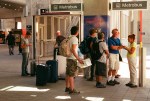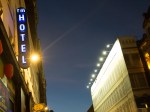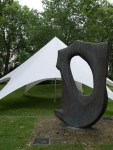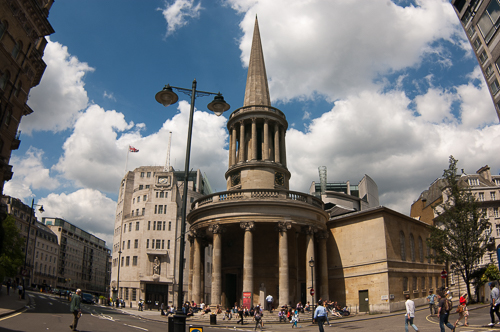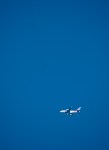The Indecisive Moment

Shot on a Sunday when the Walthamstow farmer’s market was taking place in the open space off the high street, by the library.
It was another bright sunny morning and with me was a Nikon D50 with a Nikkor 24mm 1:2.8 manual focus lens. This gave the equivalent angle of vision to a 35mm lens on a full frame camera – plenty wide enough to get near subject in without having to back off too far in the confined spaces between stalls, but not so wide that there was a lot of distortion around the edges. My intention was to take exposure and focus out of the equation by stopping the lens down to F11 and sliding infinity focus to the point between f8 and f11 on the lens’s depth scale. At ISO 200, this gave a useable shutter speed of 1/125th sec, if I exposed to compromise between the need to not overexpose the areas lit by the sun while still getting detail in the shaded areas under the stalls’ awnings.
Also of course, this is the classic formula since the 30s for street photography – fixed focal length 35mm lens set to the hyperfocal values. forcing you to get close to your subjects. I shot 4 sequences at the market. Below are the combined results of the middle two (which in effect ran into one another) with comments.

1 – approaching the market
A reasonable opening – cropped for the header, above – giving a fair idea of the area covered by the market, but nothing special. The two figures moving in towards the stands are ok, but would be much better if the were slightly to the left of the first row of stalls. To get this better, I could have moved off to my left and waited for another couple of people to enter the shot, but didn’t, feeling it would be better to get in closer, rather than spend time getting a more perfect establishing shot.

2: veg stall #1
Moving straight in towards the central stall nearest me, I took this. There is a nice array of shoppers’ faces to the left and centre, but not enough of the two stall-keepers and the fact the bigger of the two is nearer the camera means there’s always the likelihood of him blocking his smaller partner. Also, there isn’t much sense of what they’re selling. I could have gone a bit to the right, but instead went left.

3: veg stall #2
Foregrounded vegetables and almost a nice picture with the shopper making interesting shapes as he reaches for something, while not obscuring the stall-keeper’s expression. And the background is shaded enough to fit the exposure of the people under the awning. So – not bad but, annoyingly, a leaflet pinned to stall’s upright almost does obscure the stall-keeper, and the woman with the blue dress and yellow shoes is neither there nor not there. A bit closer and more angled down from slightly to the left would have cleared the shopkeeper more and removed the woman from the frame. However, it was a fluid moment and didn’t come together like this again.

4: veg stand #3
I skirted round the back of the stand to the other side, getting more of an idea of the produce offered but moving me too far away from the action and interposing the rather annoying and soft flowers in the foreground. The two shoppers and the stall-keepers almost make a nice diamond/square, and the timing of passing over both goods and money almost comes off, but a half step to my left would have been better.
Also, the background (the north side of the High Street) is obviously much, much more strongly lit than the stalls. #3 is definitely better, I think. I took one more shot from the same angle, moving from landscape to portrait (5) but it is no better (though might work cropped square).

6 – phone man #1
I’d been clocked by the people at the stall, and rather than get involved in some form of interaction with them, I turned away to my right and saw this where the man on the phone in the centre and the V-shape of the two angle produce racks caught my eye.

7: phone man #2
I pressed on and took 7…

8: phone man #3
…moved in closer and – having been spotted and being unable to read whether my taking pictures was viewed as good, bad or neutral because of the man’s sunglasses…

9: phone man #4
…I pulled back again. The closer shot with him looking into the lens (8) works best, I think with the awning and the stall forming a rough oval around him.

10: phone man #5
The man finished his call and began to move away; I moved closer again and quite like the abstract planes of the over-exposed background, the array of veg and the flatness of the awning in the top left and centre, framing the three people in the bottom left of the frame. If the aluminium pole wasn’t hiding the bearded man, and the woman wasn’t leaning out of the left of the frame, it might be quite a nice picture. Half a step left?
No! – I had already noticed the jam and chutney stall in the background, and had moved off to the right and gone around the stall to get closer. If the aluminium pole wasn’t hiding the bearded man, and the woman wasn’t leaning out of the left of the frame, it might be quite a nice picture. Half a step left? No! – I had already noticed the jam and chutney stall in the background, and had moved off to the right and gone around the stall to get closer.

11: chutney #1
I took this. It’s got good clean edges and the various planes as you move away from the camera are broken enough by the numerous rectangles formed by awnings, signs and other stuff to let your eye settle on the grounp of people – 2 adults, two children and the stall-keeper – with the interaction between the keeper and the boy on the right centring the group and giving the picture obvious narrative possibility. But other than squares and rectangles, there’s nothing going on in the left half of the picture. I stepped in and round…
-

-
12: chutney #2
-

-
13: chutney #3
-

-
14: chutney #4
…and someone pushed a pushchair in from the left of the frame. I tried to compensate and 16 almost works, but the hand coming in from the left holding the pushchair distracts from everyone else’s focus on the central area of the frame.

15: chutney #5
I stepped back. Again this works, I think, with the slightly off centre grouping of red or crimson people and objects surrounded by blues and whites is quite pleasing, and would probably become more so with a slight crop to remove some of the seated people to the left and to move the main stall more off centre. I stepped back in closer, and it all fell to pieces somewhat (16).
-

-
16: chutney #6
-

-
17: chutney #7
-

-
18: chutney #8
-

-
19: chutney #9
-

-
20: chutney #10
-

-
21: chutney #11
And then – 17-20 – I moved round to the side to try and get something of everyone’s faces; it sort of worked but there was a gulf between the stall-keeper and the shoppers if the picture was portrait (although I quite like the jam-bottles) and when I tried landscape – 21 – it’s a bit better, but not lots better. Tilting down a bit might have helped here.

22: chutney # 12
I went round towards the back of the stall and took this before realising the whole sequence had probably peaked somewhere between 11 and 15. Admitting this, I explained what I was doing to the stall-keeper, took a conventional portrait of the stall-keeper and left….

24: the stall-holder
All in all then, not the best day’s shooting I’ve ever had (If I’d been Garry Winogrand, this would probably have been one of the films that wouldn’t have got developed; and I’m sure Cartier-Bresson had days when only thin boys jumped over unreflective puddles behind the Gare Saint Lazare…). Some of the results – particularly with a couple of slight crops – are ok, I suppose. I don’t think I ever came particularly close to seizing a decisive moment (and the continually changing relationships between numerous people make this harder of course), but possibly with the object of the exercise being to document the moving into position as well as the final “good” composition, that was never going to happen here.
“Good” photography was made harder by the preserve stand’s awning casting a very persistant reddish cast on everything; I’ve included some pictures as shot and some at least partially colour-corrected.
I think it is a good exercise to have done and a better one to have thought about, but the thing I always find nerve-wracking about taking pictures in public places – the spoken or unspoken negotiation that goes on between you and the strangers in your pictures – was made worse by the need to document getting into postion as this removed the ability to get in place and then take one, or two quick shots before moving away. I felt very uncomfortable and – by the time I’d gone to a nearby pub to review what I’d done over a soda and lime – I was quite drained by the experience.


